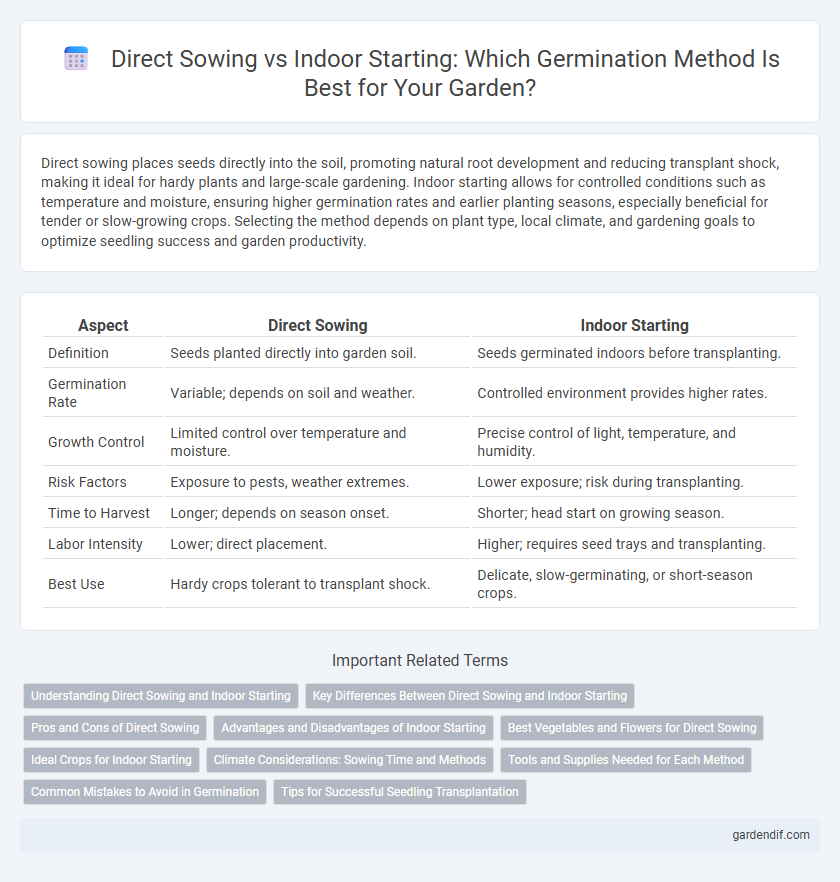
Direct Sowing vs Indoor Starting Illustration
Direct sowing places seeds directly into the soil, promoting natural root development and reducing transplant shock, making it ideal for hardy plants and large-scale gardening. Indoor starting allows for controlled conditions such as temperature and moisture, ensuring higher germination rates and earlier planting seasons, especially beneficial for tender or slow-growing crops. Selecting the method depends on plant type, local climate, and gardening goals to optimize seedling success and garden productivity.
Table of Comparison
| Aspect | Direct Sowing | Indoor Starting |
|---|---|---|
| Definition | Seeds planted directly into garden soil. | Seeds germinated indoors before transplanting. |
| Germination Rate | Variable; depends on soil and weather. | Controlled environment provides higher rates. |
| Growth Control | Limited control over temperature and moisture. | Precise control of light, temperature, and humidity. |
| Risk Factors | Exposure to pests, weather extremes. | Lower exposure; risk during transplanting. |
| Time to Harvest | Longer; depends on season onset. | Shorter; head start on growing season. |
| Labor Intensity | Lower; direct placement. | Higher; requires seed trays and transplanting. |
| Best Use | Hardy crops tolerant to transplant shock. | Delicate, slow-germinating, or short-season crops. |
Understanding Direct Sowing and Indoor Starting
Direct sowing involves planting seeds directly into the soil where they will mature, offering natural exposure to environmental conditions but requiring optimal outdoor temperatures and soil quality for successful germination. Indoor starting allows seeds to germinate in a controlled environment with regulated temperature, humidity, and light, enhancing early growth and extending the growing season, especially in regions with short or unpredictable weather patterns. Choosing between direct sowing and indoor starting depends on seed sensitivity, climate conditions, and the desired timing for transplanting seedlings to achieve maximum germination rates and healthy plant development.
Key Differences Between Direct Sowing and Indoor Starting
Direct sowing places seeds directly into the garden soil, exposing them to natural environmental conditions, which can enhance hardiness but depends heavily on favorable weather. Indoor starting allows for controlled temperature, moisture, and light, promoting early germination and stronger seedlings before transplanting. Choosing between methods hinges on plant type, climate, and desired growing timeline, with indoor starting often used for long-season crops and direct sowing suited to hardy, fast-growing plants.
Pros and Cons of Direct Sowing
Direct sowing promotes natural root development and reduces transplant shock, making it ideal for plants with sensitive roots like carrots and beans. It saves time and resources by eliminating the need for indoor space and transplanting, but risks include uneven germination and vulnerability to pests, weather, and soil conditions. Direct sowing works best in stable climates with well-prepared soil, as poor conditions can lead to lower success rates compared to controlled indoor starting.
Advantages and Disadvantages of Indoor Starting
Indoor starting offers early control over temperature and moisture, promoting stronger seedling development before transplanting. Limited space and increased risk of root disturbance during transplanting can hinder growth, making timing and technique crucial. This method also reduces exposure to outdoor pests and harsh weather, improving survival rates for delicate seeds.
Best Vegetables and Flowers for Direct Sowing
Best vegetables for direct sowing include beans, carrots, radishes, and peas, as they thrive when planted directly into garden soil and develop strong root systems. Flowers such as sunflowers, marigolds, and zinnias are also ideal for direct sowing, benefiting from natural outdoor conditions that promote vigorous growth. These plants generally prefer stable soil temperatures and steady moisture, making them well-suited for outdoor germination without the need for indoor starting.
Ideal Crops for Indoor Starting
Certain vegetable and herb seeds respond best to indoor starting due to their need for controlled temperature and moisture conditions during germination, such as tomatoes, peppers, and basil. Indoor starting enhances seedling vigor and extends the growing season by protecting young plants from early frost and pests. Delaying transplant until seedlings develop strong root systems ensures higher survival rates and robust growth in the garden.
Climate Considerations: Sowing Time and Methods
Choosing between direct sowing and indoor starting depends heavily on climate factors such as temperature, frost dates, and growing season length. Direct sowing suits regions with stable, warm soil conditions conducive to seed germination, while indoor starting allows for controlled environments in cooler climates, enabling earlier planting and extended growing seasons. Understanding local climate patterns and frost risks ensures optimal sowing time and method selection for successful germination and crop yield.
Tools and Supplies Needed for Each Method
Direct sowing requires tools like a garden trowel, seed packets, soil preparation equipment, and watering cans for efficient planting in outdoor beds. Indoor starting involves supplies such as seed trays or containers, grow lights or sunny windowsills, seed-starting mix, and humidity domes to create controlled germination conditions. Both methods benefit from labels for seed identification and a gentle misting spray bottle to maintain moisture.
Common Mistakes to Avoid in Germination
Common mistakes in germination include overwatering seeds during direct sowing, leading to rot, and neglecting proper temperature control when starting seeds indoors, which can inhibit sprouting. Using poorly drained soil outdoors often causes seedling damping-off, while indoors, insufficient light exposure results in weak, leggy seedlings. Ensuring correct moisture levels and optimal environmental conditions enhances germination success rates.
Tips for Successful Seedling Transplantation
When transplanting seedlings, ensure roots are well-developed but not root-bound before moving them outdoors. Harden off seedlings by gradually exposing them to outdoor conditions over 7-10 days to reduce transplant shock. Use high-quality, well-draining soil and water thoroughly immediately after transplanting to encourage strong root establishment.
Direct Sowing vs Indoor Starting Infographic

 gardendif.com
gardendif.com